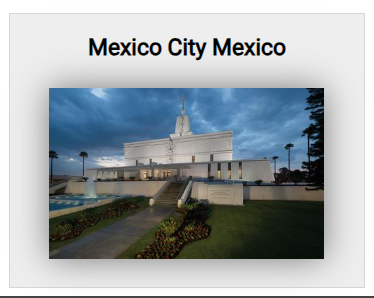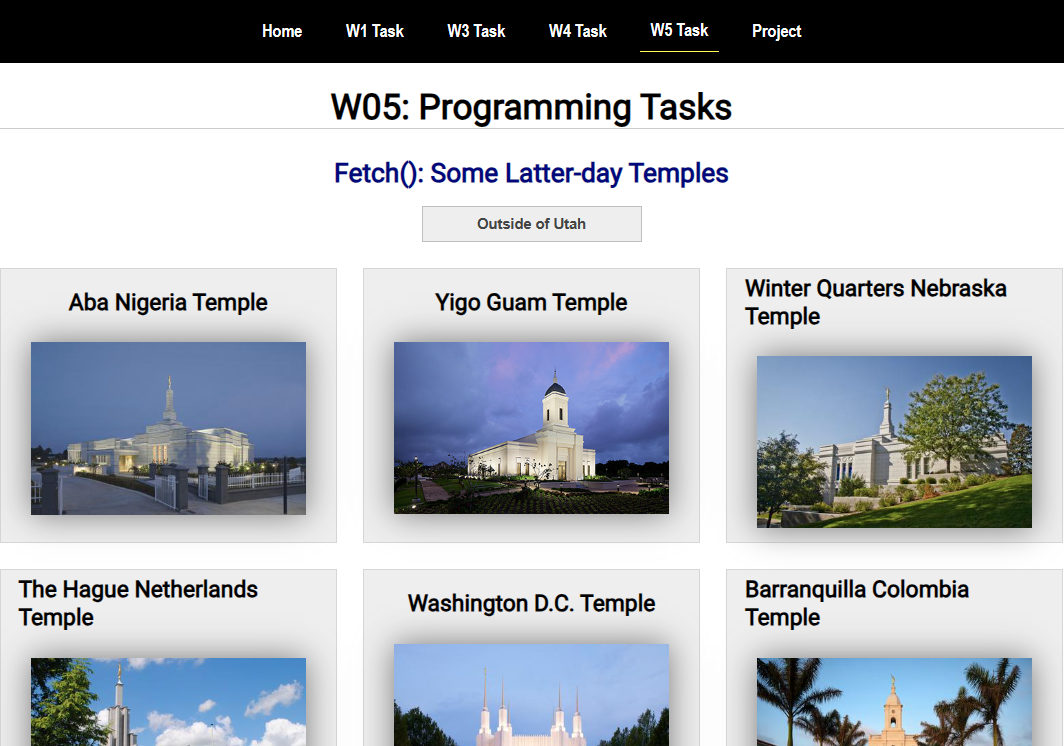W05: Programming Tasks
Instructions
Setup
- Download the starter files (2). Place the
w05-task.htmlfile on the rootcse121bfolder and thew05-task.jsfile in thescriptsfolder.
Review the Public Temple Data
- Navigate to this temple JSON file by clicking on the link. Your browser will handle the parsing of the data to make it readable.
- Review the temple data format and naming structure.
Complete the following steps in the w05-task.js file. Do not alter the
w05-task.html file.
Declare Global Variables
- Declare a
constvariable namedtemplesElementthat references the HTML div element that eventually will be populated with temple data. - Declare a global empty array variable to store a list of temples named
templeList.
Function: displayTemples()

This function will build a temple display "card" for each item in the temple list passed to the function.
-
Declare a function expression using
constnameddisplayTemplesthat uses an arrow function to accept a list of temples as an array argument.Check Your Understanding
const displayTemples = (temples) => { - Process each temple in the temple array using a forEach method and do the
following for each temple item:
- Create an HTML
<article>element (createElement). - Create an HTML
<h3>element and add the temple'stempleNameproperty to this new element. - Create an HTML
<img>element and add the temple'simageUrlproperty to thesrcattribute and the temple'slocationproperty to thealtattribute. - Append the
<h3>element and the<img>element to the<article>element as children. (appendChild) - Append the
<article>element to the globaltemplesElementvariable declared in Step 2.Check Your Understanding
templesElement.appendChild(article);
- Create an HTML
Function: getTemples()
Get JSON temple data using fetch().
- Create another function expression called
getTemples. Make it anasyncanonymous, arrow function.Check Your Understanding
const getTemples = async () => { - In the function, declare a
constvariable namedresponsethatawaits the built-infetchmethod calling the temple data, absolute URL given in Step 2 above.Check Your Understanding
const response = await fetch("https://byui-cse.github.io/cse121b-ww-course/resources/temples.json"); - Convert your fetch response into a JavaScript object (
.json) and assign the result to thetempleListglobal array variable you declared in Step 3 above. Make sure the the execution of the code waits here as well until it finishes.💡If you are stuck with any of these steps, consider using the learning activity materials provided. - The last statement in the
getTemplesfunction calls thedisplayTemplesfunction and passes it the list of temples (templeList).💡A good idea here is to test your code by calling thegetTemplesfunction at the end of your JavaScript file. This will make sure that your code works before you move on to the next step. You canconsole.log(templeList)to review the results.
Function: reset()
Clear the displayed list of temples.
- Declare a function expression named
resetthat clears all of the<article>elements from thetemplesElement.
Function: filterTemples()
Sort the list of temples by the selected value of the HTML select
element with an ID of filtered. The preset selections include temples located in
the state of Utah, those outside the state of Utah, and temples built before 1950 on the list.
- Declare a function expression named
filterTemples. - The function should accept a argument in a parameter named
temples. - In this function, first call the
resetfunction to clear the output. - Define a variable named
filterthat obtains thevalueof the HTML element with the ID offiltered(The pull-down menu). - Use a
switchstatement that uses thefiltervalue as the selector responding to four (4) cases. - For each case, call the
displayTemplesfunction using an filter statement that filters thetemplesparameter for the four options provided.- "utah": filter for temples where the
locationcontains "Utah" as a string. - "notutah": filter for temples where the
locationdoes not contain "Utah" as a string. - "older": filter for temples where the
dedicateddate is before 1950. (compare versusnew Date(1950, 0, 1)). - "all": no filter. Just use
temples as the argument.
- "utah": filter for temples where the
Event Listener: filterTemples Element change
- Add a
changeevent listener to the HTML element with an ID offilteredthat calls thefilterTemplesfunction and sends a arrow function result with thetempleListas the argument.Check Your Understanding
document.querySelector("#filtered").addEventListener("change", () => { filterTemples(templeList) });

Testing
- Verify that you are calling
getTemples()at the bottom of the JavaScript file. - Test your work by using Live Server and debug as needed.
Submission
- Commit and push your work to GitHub.
- Submit the GitHub Pages rendered URL in Canvas.
💡Here is an example of what the URL should look like:
https://yourgithubusername.github.io/cse121b/w05-task.htmlor
https://yourgithubusername.github.io/cse121bis OK because each assignment is already included in the provided navigation structure on this home page for the course.
Stretch
Add additional options such as sorting the temples alphabetically.
